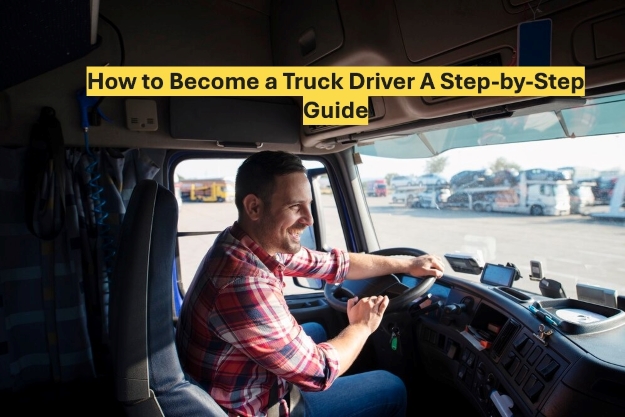How to Become a Truck Driver A Step-by-Step Guide

If you’ve ever considered a career behind the wheel, becoming a truck driver could be an excellent choice. The trucking industry offers countless opportunities for individuals seeking a stable, rewarding career. Whether you’re looking for independence on the open road or the potential to earn a competitive salary, truck driving has something to offer.
In this step-by-step guide, we’ll walk you through everything you need to know about becoming a truck driver—from the qualifications required to obtaining a Commercial Driver’s License (CDL) and securing high-paying jobs. We’ll also cover what you can expect in terms of salary, job prospects, and how to set yourself up for success in this thriving industry.
Let’s get started on your journey to becoming a truck driver.
1. Understanding the Trucking Industry
The first step in pursuing a career as a truck driver is to understand what the job entails. Truck drivers are responsible for transporting goods across long distances, often crossing state lines or even traveling internationally.
The trucking industry is a cornerstone of the global economy, ensuring goods are moved efficiently from one place to another. The demand for truck drivers has steadily increased over the years, and as the economy grows, the need for skilled drivers continues to rise.
Types of Trucking Jobs:
- Long-Haul Trucking: These jobs involve driving across long distances for days or weeks at a time, often without returning home every night.
- Regional Trucking: You drive a set route within a specific region. While you’re still on the road a lot, you usually return home more often than a long-haul driver.
- Local Delivery: As a local truck driver, you’ll remain close to home and may work regular hours, delivering goods to local businesses or warehouses.
Understanding the different types of trucking jobs will help you decide which career path to take. Each type of trucking job comes with its own unique set of challenges and rewards.
2. Meet the Basic Requirements to Become a Truck Driver
Before diving into the CDL process, it’s important to ensure you meet the basic requirements to become a truck driver. The qualifications are straightforward, but there are some critical steps involved in getting started.
Age Requirement:
To drive a commercial vehicle, you must be at least 21 years old if you plan to drive across state lines (interstate). However, if you’re only driving within your state, you may begin at 18 years old.
Valid Driver’s License:
You must have a valid Class D driver’s license, which is a standard car license in the U.S. Without a clean record in your personal driving history, it may be more difficult to qualify for a CDL.
Physical Fitness:
Truck driving can be physically demanding. You will need to pass a medical examination to ensure you are fit to drive for extended periods of time. Your eyesight, hearing, and overall physical health will be assessed to determine if you meet the required health standards.
It’s important to be aware that your health could affect your ability to work in the industry. Make sure you meet the health standards to avoid delays in getting hired.
3. Obtain Your Commercial Driver’s License (CDL)
One of the most critical steps in becoming a truck driver is obtaining your Commercial Driver’s License (CDL). The CDL is required to operate large trucks or buses and is issued by the state in which you reside.
CDL Training Program:
Before applying for your CDL, it’s essential to complete a CDL training program. This program will teach you how to operate a large commercial vehicle, handle the truck in different conditions, and follow safety procedures on the road. You can attend a training program through:
- Truck driving schools
- Community colleges
- Employers offering CDL programs
Written Knowledge Test:
Once you complete the training, you’ll need to pass a written knowledge test. The test will include questions on road signs, traffic laws, and the specific rules governing commercial driving. You’ll also be tested on various trucking regulations, such as hours of service rules, weight limits, and hazardous materials handling (if applicable).
Road Skills Test:
After passing the written test, you’ll take a road skills test in which you’ll drive a commercial vehicle under the supervision of an examiner. The examiner will evaluate your ability to control the vehicle, make turns, back up, and park safely, among other driving skills.

4. Choose Your Trucking Career Path
Once you’ve obtained your CDL, it’s time to decide which type of trucking job you want to pursue. Each career path offers different experiences, pay, and benefits.
Owner-Operator vs. Company Driver:
- Owner-Operator: As an owner-operator, you own your truck and operate as an independent contractor. While you have more control over your schedule and pay, you’re also responsible for your truck’s maintenance, fuel costs, and insurance.
- Company Driver: If you choose to work as a company driver, you’ll drive a truck that belongs to the company. Your employer will provide maintenance, insurance, and the route details. While you may have less flexibility, it’s an easier entry into the industry.
Specialized Trucking:
Some drivers prefer specialized trucking, such as transporting hazardous materials, oversized loads, or livestock. These jobs often pay higher wages due to the increased responsibility and risk involved.
5. Gain Experience as a Truck Driver
While it’s possible to start working as a truck driver immediately after getting your CDL, many companies prefer to hire drivers with some experience. If you’re new to the industry, here’s how you can gain the experience you need:
- Entry-Level Trucking Jobs: Most companies hire entry-level drivers, providing them with on-the-job training and mentorship from experienced drivers.
- Apprenticeship Programs: Some companies offer apprenticeship programs where you drive under the supervision of a seasoned driver until you’ve gained enough experience to handle routes on your own.
As you gain experience, you can increase your earning potential and move toward more independent roles such as owner-operator or long-haul trucking.
6. Find a Trucking Job
Once you have the experience, it’s time to find a trucking job. Here’s how to go about it:
Job Boards:
Websites like Indeed, Monster, and Glassdoor regularly post trucking jobs. You can filter the search results based on your location, experience, and job type.
Company Websites:
Many large trucking companies list their job openings directly on their websites. By checking their career pages, you can apply directly to companies you’re interested in working for.
Recruiting Agencies:
Some agencies specialize in matching truck drivers with employers. These agencies can help you find a job that aligns with your career goals.
7. Set Up Your Own Trucking Business (for Owner-Operators)
If you choose to be an owner-operator, you’ll need to establish your own business. This includes:
- Obtaining insurance (liability, cargo, and personal injury)
- Registering your business with the appropriate state and federal agencies
- Managing taxes, payments, and expenses
Running your own trucking business offers great potential for high earnings but comes with increased responsibilities.
8. Understand Salary and Earning Potential
Truck drivers’ earnings can vary widely depending on factors such as experience, location, and job type. For example:
- Local truck drivers: Can expect to earn between $40,000 to $60,000 annually.
- Long-haul drivers: Typically earn between $60,000 and $100,000 annually, with experienced drivers potentially earning even more.
Owner-Operators:
As an owner-operator, you have the potential to earn more, but you’ll also have higher expenses for things like fuel, maintenance, and insurance.
FAQs
-
How long does it take to get a CDL?
Most CDL programs take 3 to 6 months to complete, including training and testing. -
Can I become a truck driver without a college degree?
Yes, a college degree is not required to become a truck driver. The most important requirement is obtaining a CDL and completing proper training. -
How much do truck drivers make?
Truck drivers can earn anywhere from $40,000 to $100,000+ annually, depending on their experience, job type, and route. -
Is there an age limit for truck drivers?
You must be at least 21 years old to drive interstate, but you can start driving locally at 18. -
How can I become an owner-operator?
To become an owner-operator, you need to purchase a truck, obtain necessary insurance, and manage your business as an independent contractor.Conclusion
Becoming a truck driver is a rewarding and lucrative career choice, offering freedom, flexibility, and opportunities for growth. Whether you choose to work as a company driver or an owner-operator, following the proper steps will help you succeed in this dynamic field. From obtaining your CDL to gaining experience and securing a job, every step is an investment in your future.




